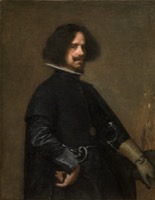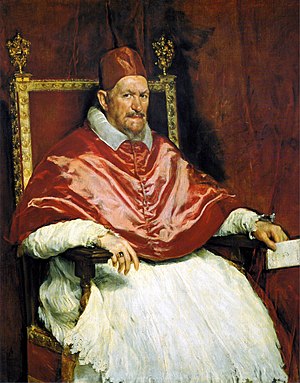 |
| Diego Rodriguez de Silva y Velásquez, Autoportrait, 1644-52 |
Without wanting to be the bringer of bad tidings, I have to be honest and say that I was disappointed by the Velázquez exhibition at the Grand Palais. While Velásquez himself did not disappoint, the staging of the exhibition did. Most disconcerting was the choice of pale grey walls, a colour that did nothing for the subtleties of the Spanish master’s dark palette. The lighting is unusually high, creating strong reflections off the grey walls. As a result, and this is the most frustrating aspect of the exhibition, the luminosity of the paintings is lost to the overexposure of their environment, and thus, visitors will struggle to appreciate the effect and force of the paintings.
 |
| Diego Rodriguez de Silva y Velásquez, Infanta Margarita Teresa in a Blue Dress, 1659 |
The paintings were also hung very close together, making it difficult to spend any length of time with a single one of them – the temptation to move through the huge exhibition was too great. I was also disappointed because, of course, with an exhibition given the amount of publicity that this one has received, my expectation was that Las Meninas be the culminating moment. The absence of Las Meninas, Las Hilanderas and various other major paintings left an empty space at the end of the exhibition. This is especially so because movement around the exhibition encourages recognition of all the concerns for which Velásquez became so well known, all of which come together in the chef d’oeuvre of Las Meninas. From very early in his career, Velásquez is thinking about perspective, lines of sight, still lives breaking the picture space, intruding into our space. But of course, that trajectory of his career and concerns doesn’t really come together without Las Meninas.
 |
| Diego Rodriguez de Silva y Velásquez, St Thomas, 1619-20 |
That said, there were moments of excitement walking through, most notably the renowned portrait of Innocent X, 1650, with his frontal placement, his seriously suspicious eyes watching our every move as we try to get a different perspective on his exquisite dress and robe. Even after all these years, the transformation of the Catholic Church, the diffusion of papal power, there is no mistaking his power and authority as he sits on his throne. Of course, the Infanta who is featured on the publicity material is sumptuous, and we feel much easier in her company than in that of Innocent X’s. Her constriction by the elaborate dress that weighs her down is palpable. And the self portraits are gentle and beautiful. These latter portraits are the most sumptuous because of Velásquez’s freedom to do what he wanted, free of his ambivalent relationship to power and authority as it is observed in the court portraits. The self-portraits also reveal the presence of an internal life, in contrast to the often expressionless, unemotive royals with their often sickly bodies. Even the paint is looser, the brushstroke more visible, in the more relaxed paintings of himself and his associates.
 |
Diego Rodriguez de Silva y Velásquez, Portrait of Pope Innocent X, 1650
From the very beginning of his career, Velásquez is not much interested in story, but fascinated with character. The portraits of the saints, Paul and Thomas (1619-20), their stories are all but elided from the image in the interest of a very correct compositional design, and the precision of the light shining in their eyes, the realism of their facial expressions. It is as if background as a place to create the context and story of their place in the world is not relevant when measured against the beauty of their faces.
.jpg&sa=X&ei=vdZYVe7QI4qGywON6oCABw&ved=0CAkQ8wc&usg=AFQjCNFHzs-k7xcRIZr5IUxhMjIdwqO-WQ)
Diego Rodriguez de Silva y Velásquez, La Forge de Vulcain, vers 1630
No comments:
Post a Comment